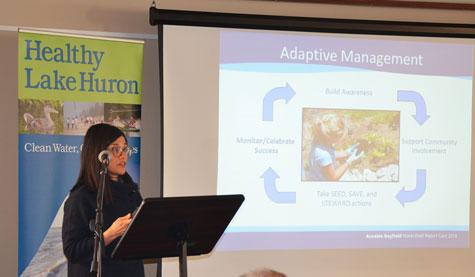Watershed Report Card released

Ausable Bayfield Conservation releases new, updated Watershed Report Card on World Water Day March 22
Report cards are completed every five years; 2018 Ausable Bayfield Watershed Report Card reports on where there are improvements, where there is room for growth
Residents of Ausable Bayfield watershed communities now have new information about the state of their forest and water resources. Ausable Bayfield Conservation released the new updated Watershed Report Card (2018) at the annual conservation awards evening held on World Water Day. Staff members compile the report cards every five years. The reports summarize monitoring data over five years based on provincial guidelines developed by Conservation Ontario. The documents are online at abca.ca at this link: http://www.abca.ca/reportcards.php. For more about conditions across the Province of Ontario visit watershedcheckup.ca at this link: http://watershedcheckup.ca/ and stateofontariowatersheds.ca at this link: http://stateofontariowatersheds.ca/.
The local Ausable Bayfield Watershed Report Card 2018 reports on the quality of groundwater and surface water, the amount of overwinter vegetative cover, and forest and wetland conditions. Mari Veliz, Healthy Watersheds Supervisor, presented report card findings at the event at Ironwood Golf Club east of Exeter on March 22, 2018. She said each small positive action – added together – can improve forest conditions and water quality. Forests in the Ausable Bayfield watershed are fragmented, according to Veliz. There is room for growth in improving forest interior, she said. In terms of streamside plant cover, some bigger rivers have buffered areas, but more buffers could be added on more creeks, she said. Wetlands help to filter water and help with flood control. There is a lot of room for growth in adding wetlands in the watershed, she said.
The Healthy Watersheds Supervisor said forest is a small percentage of the watershed. She said it’s important, in this productive “working landscape,†to find practical ways to reduce water running off of land during storm events where there is little forest. One way to reduce runoff is to plant cover crops and increase year-round cover. The new report cards look at overwinter vegetative cover and staff hope to see that cover percentage increase. “If there are opportunities to cover some of that landscape we don’t have as many runoff opportunities that come from the water running across the landscape,†said Veliz. More plant cover helps to reduce runoff and that adds protection to water quality.
Report cards offer letter grades to inform you about existing forest conditions and groundwater and surface water quality in your local watershed. Sometimes, those grades reflect the make-up of that area. A watershed with a lot of forest cover and less intensive land uses, for instance, might have better water quality. A watershed with less cover and more intensive land uses may have a lower grade. It may not be possible in the near term to turn a D grade into a C grade (or to change a C to a B) but even if letter grades don’t change that doesn’t mean there aren’t improvements being made. Examples of improved surface water quality include some reductions in E. coli and phosphorus. “We have grades that suggest a watershed that does need improvement but some of the things we’re finding show there is room for optimism,†Veliz said. “The grades aren’t really changing very much but it’s important to focus on some of the numbers over time – for instance, we have (some) E. coli numbers that have gone down by half.†The presenter said this is a “good sign†that reflects best management practices landowners, residents, and community groups adopt across the landscape.
In terms of groundwater conditions, the new report cards say there are generally few signs of groundwater contamination from chloride and nitrate in most cases. Nitrate is “higher than we would like to see,†higher than background levels, at three of 14 provincial groundwater monitoring wells in the watershed, according to the Healthy Watersheds Supervisor. Those three particular wells are located where there are known issues reflecting factors that include topography. In one of the monitoring wells, there is a presence of chloride higher than background levels.
The Conservationist of the Year Award winners, Rick Quinn and Diane Hawthorne and their family, have planted trees and restored wetlands. Veliz praised their work and said wetland restoration and tree planting are among the actions citizens can take to protect water, soil and living things in the watershed. Other actions (to ‘save, seed, and steward’) include planting of cover crops and more year-round vegetative cover, she said. “We have to continue to look for those save, and seed, and stewardship opportunities,†according to the Healthy Watersheds Supervisor. She provided ways people can ‘ACT’ (Avoid – Improve filtration; Control – at or near the source; and Trap and Treat) to protect creeks, rivers, and the lake through positive actions in urban and rural areas.
She said buffers; two-stage ditches; grassed waterways; and berms are all ways to manage runoff in rural areas. The most effective actions, however, are the ones that hold back, slow down, and infiltrate the stormwater running across the land before it reaches berms and buffers. Those ‘ACTions’ include reduced tillage and cover crops.
Reducing and slowing down runoff is also important in towns and villages. “The same goes for urban actions – we think of stormwater ponds but, really, they’re the last line of defence.†She said more rain barrels, rain gardens, natural cover, and less impervious pavement are “the kinds of things we should be working towards to make improvements to our landscapes.â€
The new Watershed Report Card salutes local partners doing projects to improve water, soil, and habitat. The Healthy Watersheds Supervisor honoured all the individuals and organizations that had received ‘thumbs up’ recognition in the document.